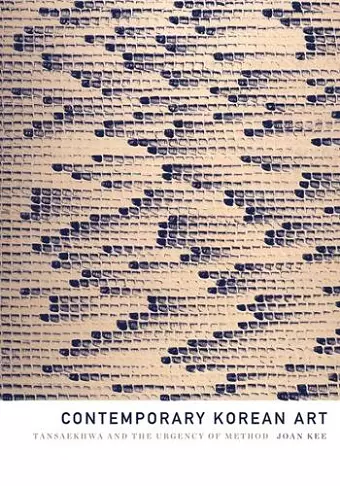Contemporary Korean Art
Tansaekhwa and the Urgency of Method
Format:Paperback
Publisher:University of Minnesota Press
Published:18th Jul '13
Currently unavailable, and unfortunately no date known when it will be back

Starting in the mid-1960s, a group of Korean artists began to push paint, soak canvas, drag pencils, rip paper, and otherwise manipulate the materials of painting in ways that prompted critics to describe their actions as “methods” rather than artworks. A crucial artistic movement of twentieth-century Korea, Tansaekhwa (monochromatic painting) also became one of its most famous and successful. Promoted in Seoul, Tokyo, and Paris, Tansaekhwa grew to be the international face of contemporary Korean art and a cornerstone of contemporary Asian art.
In this full-color, richly illustrated account—the first of its kind in English—Joan Kee provides a fresh interpretation of the movement’s emergence and meaning that sheds new light on the history of abstraction, twentieth-century Asian art, and contemporary art in general. Combining close readings, archival research, and interviews with leading Tansaekhwa artists, Kee focuses on an essential but often overlooked dimension of the movement: how artists made a case for abstraction as a way for viewers to engage productively with the world and its systems. As Kee shows, artists such as Lee Ufan, Park Seobo, Kwon Young-woo, Yun Hyongkeun, and Ha Chonghyun urgently stressed certain fundamentals, recognizing that overwhelming forces such as decolonization, authoritarianism, and the rise of a new postwar internationalism could be approached through highly individual experiences that challenged viewers to consider how they understood their world rather than why.
Against the backdrop of the Cold War, decolonization, and the declaration of martial law in South Korea, these artists asked questions that continue to resonate today: In what ways can art matter to the world? How does art exert agency when its viewers live in times of explicit or implicit duress? How can specific social and political conditions inspire or influence methods and styles?
"This book provides a comprehensive overview of the most controversial and influential artistic movement in contemporary Korean art. With detailed formal analysis on the important artworks and locating them within the broader historical and intellectual framework, Joan Kee vividly portrays how Korean artists responded to the international art world and positioned Tansaekhwa as an alternative to Euro-American art. Contemporary Korean Art makes essential reading for anyone interested in the non-Western artists’ negotiations to global art in the twentieth century." —Insoo Cho, Korea National University of Arts
"Rich in analysis and description, Kee’s book traces the development of Korean painting and issues of national artistic identity as a reflection of the country’s economic growth and political turmoil over the past five decades. This pioneering, generously illustrated tome deserves a place in every serious collection of books about modern art in Asia."—ArtAsiaPacific
"Kee does an excellent job of placing Tansaekhwa artists in context, giving the reader a greater understanding of how the artists fit into contemporary Korean art and the international art world. Readers who are not familiar with Korean history will be well-served by the historical context that the author provides."—Art Libraries Society
"A gorgeous and thoughtful introduction to the history of contemporary art in Korea. It’s a beautiful and fascinating book."—New Books Network
"Kee displays throughout the book a rare sensitivity to formal qualities of the visual materials before her and exhaustive knowledge of theoretical discussions that surrounded and gave rise to the movement, all while writing a refined but accessible prose without a shred of excess."—Journal of Asian Studies
"Kee successfully carves out a definable and cultivated place for the Tansaekhwa artist in the global history of modernist abstraction and contemporary art."—Orientations
"This book is required reading for anyone with even a passing interest in Korean art of the 20th century."—Korean Quarterly
"The horizontally evanescing yet rhythmically resurging dots of the frontispiece by Lee Ufan invites us into the exciting journey offered by this by this elaborately strucutured narrative of tansaekhwa."—Korean Studies
"This book delivers a solid argument, displays meticulous research, and offers an in-depth reading of artworks. The questions Kee’s intervention raises will make this book an important point of reference and engagement for any future studies of contemporary Korean and non-Western art."—Art Journal
"Kee’s attention to forms and method is brilliant, and her theoretical knowledge of contemporary Korean art provides pleasurable reading for even non-art historians."—Pacific Affairs
- Runner-up for Contemporary Korean Art 2014
ISBN: 9780816679881
Dimensions: 254mm x 178mm x 51mm
Weight: unknown
384 pages